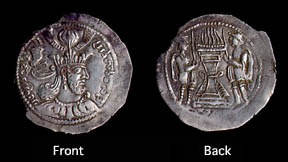
'Varhran of Gandhara' (circa 340 AD?)
Silver Drachma
Mid-4th century
Diameter: 2.9 cm
Weight: 3.84 grams
Copyright © T. K. Mallon-McCorgray, 1996
Zoroastrianism traveled east out of Iran along the trade routes, carried by Sogdian, Parthian and Sassanian merchants. There is a difference, however, between practicing a faith and proselytizing it, and it is difficult to know whether or not these merchants attempted to win to converts during their journeys.
Trade was not the only method by which Zoroastrianism made its way East. As Sassanian rulers of the third and fourth centuries enlarged their territories through military expansion, Zoroastrianism traveled along with their armies. Around the year 230 CE Ardashir I and his son Shapir I took the provinces of Bactria and Gandhara from the Kushans, and put these realms under the control of Sassanian nobles called "Kushanshahs."
The face of this coin depicts one of the Kushanshahs, 'Varhran of Gandhara,' as the Pahlavi legend tells us, a noble believed to have ruled around 340 CE. On the coin's reverse we find an illustration of a Zoroastrian fire altar. The Kushanshahs relied on religion to help legitimize their authority (much in the same way as the Sassanian rulers to the West) by associating their rule with the purity and wisdom symbolized by the Zoroastrian sacred flames. In many ways the design here is similar to that of the British Museum's Ardashir I coin, with the addition of two attending figures holding what appear to be staves. Such attendants are not uncommon on Sassanian coins, and may depict Zoroastrian magi priests.